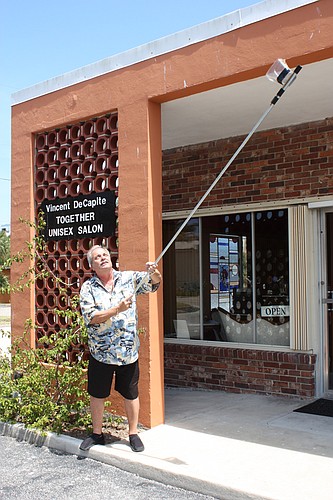- April 16, 2024
-
-
Loading

Loading

Rooftop colony is an annual tradition.
Ormond Beach has its own version of the swallows of Capistrano. For six years, the “least terns of Ormond Beach” have returned each spring to an office building rooftop on Vining Court for an approximate six-week visit, to nest and hatch their young.
They prefer the beach, but since that area is crowded with humans, they adapt to other suitable spots.
Many customers and employees find them fascinating and fun to watch. They swoop up as a flock to make a food run to the beach every morning, and again in the late afternoon, returning with silvery fishes dangling from their beaks.
But the drawback is evidenced by the parking lot covered with white spots, caused by their droppings.
“It’s been the biggest mess,” said a customer, who wished not to be identified, as she walked to her car. “I’m glad they are here, but now I have to clean my car.”
Most realize it’s a temporary situation.
“They don’t bother us,” said Vincent DeCapite, co-owner of Together Unisex Salon. “It’s seasonal. They come and they go. A good rain washes off everything.”
Stylist Donna Whitfield, who leaves her car in the lot all day, says she just washes it off when she gets home.
“We can all live together,” she said. “I enjoy watching them.”
The birds apparently find the flat, tar and gravel roof similar to spoil islands, where they also nest.
David Hartgrove, conservation chair for Halifax River Audubon, said being able to find a place to nest “is crucial” for the least terns. Their numbers are declining and they are listed as a species of special concern.
Unfortunately, tar and gravel is an old technology, and a different material, such as foam, is being used as roofs are being replaced. He pointed out that Volusia County, when it became necessary to replace the roof at City Island Library, spent extra money to keep a portion of it tar and gravel.
He said there are 25 to 30 nesting pairs on the roof at Vining Court building.
He said that this year they are not nesting on City Island Library, but there is a colony on a building at Bethune-Cookman University, and for the first time, on Disappearing Island near Ponce Inlet.
“They have a mysterious agenda,” he said “One year a place will be full of birds and the next year, nothing.”
Aside from watching the birds, some of the employees have been actively involved in saving the chicks, which sometimes fall off the roof.
DeCapite and salon co-owner Ronnie Wildermuth were provided with a chick-a-boom, a device used to place chicks back on top of roofs. It consists of a long pole with a large cup on the end. The rescuer scoops up the chick and then flips them back onto the roof. Hartgrove said it was invented by the Audubon group in Tampa.
“I chase them until they get exhausted and then I can catch them,” said DeCapite.
Jennifer Winters, habitat conservation plan manager for Volusia County. said it’s OK to handle a chick and place it back on its nest. Birds will not abandon chicks handled by humans, as some people believe.
“That’s actually not true,” she said.
Dr. Richard Brown, a dentist in the office building, said they didn’t bother him, and they are a good conversation piece with customers.
“Most people understand we’re near the beach,” he said. “We enjoy having them. They are interesting.”
DeCapite, who takes time from his work to rescue the chicks, says the mess the birds leave behind isn’t that much of a problem.
“As the saying goes, (stuff) happens,” he said.